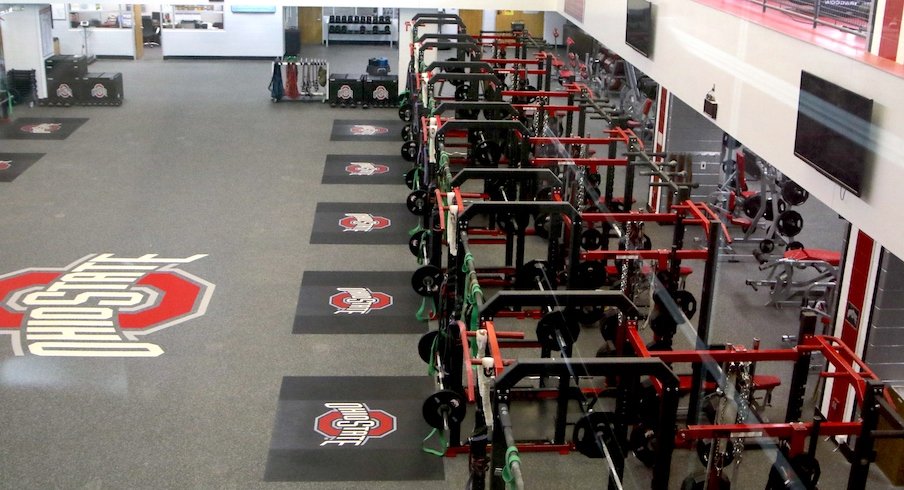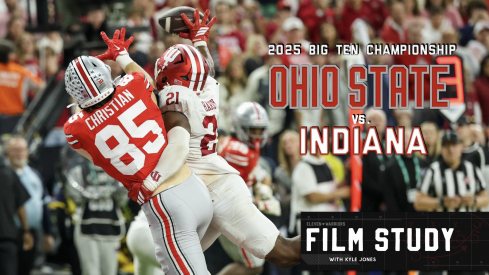Ohio State is planning on reopening the Woody Hayes Athletic Center to football players on June 8, but that doesn’t mean that things are going back to normal quite yet.
Pending final approval from the university’s post-pandemic task force, Ohio State will reopen its athletic facilities to football players in less than three weeks, allowing them to utilize those facilities for voluntary workouts. That decision comes after the NCAA’s Division I Council voted Wednesday to allow college football and basketball teams to resume voluntary workouts on June 1.
Required team activities will still be prohibited through the end of June, though, and there will continue to be many guidelines in place that limit how many Buckeyes can work out together at once. While Ohio State is expecting some of its football players to be back on campus when the Woody Hayes Athletic Center reopens, it’s also expecting that some of them will hold off on returning until later.
When the WHAC and the adjacent Schumaker Complex initially reopen, football players will be required to sign up to work out at specific times. No more than 10 players will be allowed in those facilities at one time, and facilities will be cleaned in between workout groups. Initially, Ohio State is expecting only about 50 total football players inside those facilities each day.
Athletes will have to undergo symptom checks, including temperature checks, each time they enter the facility – though they won’t actually be tested for COVID-19 – and will be expected to maintain physical distancing in compliance with state orders and recommended best practices.
With those restrictions in place, though, Ohio State athletic director Gene Smith believes reopening the WHAC will be a benefit to player safety – especially now that Ohio gyms and fitness centers are set to reopen next week – particularly for those football players who have remained in Columbus or whose families live locally.
“We feel that the facilities that we have, with the protocols that we can put in place relative to symptom checks and cleanliness and all those type of things is the best-protected environment,” Smith said on a teleconference Wednesday. “Obviously, there’s a lot of health clubs and workout places, spas, gyms that will do an excellent job. But some of our young people are not in environments where they have access to those best facilities. They’re not. And so, we want to provide them the opportunity to have access to the state-of-the-art equipment that we have, but also our medical people, our trainers. And we want to continue to make sure that they’re in the safest environment possible.”
Ohio State’s initial reopening of athletic facilities on June 8 will be limited to the WHAC and the Schumaker and for football players only. Smith said he is hopeful that student-athletes from other fall sports will be able to work out in some of the other athletic facilities by the end of June, but he also recognizes that it is important to start gradually due to the uncertainty that still surrounds the spread of COVID-19.
“We want to crawl before we walk and run, and football of course, makes sense to start with,” Smith said. “We hope that what we learn by having football in the facility will allow us to come up with a strategy for the other sports down the road. And possibly open up other facilities down the road. But we’re not gonna rush it.”
Student-athletes who return to Ohio State after being away from campus will be evaluated by Ohio State’s medical staff before they return to the athletic facilities, but they will not be required to quarantine unless it is determined that they should on an individual basis.
Smith said Ohio State has not yet determined exactly what will happen if a player tests positive for COVID-19, but he said he will lean on Ohio State’s medical experts to decide the proper course of action.
“We feel pretty confident that through our symptom checks and our hygiene implementations, we should be fine,” Smith said. “Now obviously, if someone gets sick, again, we turn to our medical staff, and they’ll give us guidance on what to do next. So it may be that they decide they should shut it down. So it depends. We have to rely on them, and we go from there.”
“We feel that the facilities that we have, with the protocols that we can put in place relative to symptom checks and cleanliness and all those type of things is the best-protected environment.”– Gene Smith on reopening Ohio State's athletic facilities
While the return to voluntary on-campus workouts for at least some players is a step in the right direction toward football season starting on time this fall, there is still much that needs to happen between now and then. While small-group workouts should suffice for June, when Ohio State wouldn’t be holding full practices anyway, the Buckeyes will ultimately need to be able to practice together as a full team for at least a month before they play their first game.
Smith said Wednesday that six weeks before the season remains the ideal scenario for the Buckeyes to be back on the field together as a full team, but that they will be prepared to adjust if that timeframe is shortened to five or even four weeks.
“Between now and then, we have to get some guidance from our advisory group at the Big Ten, get some guidance from our local experts on what we need to do,” Smith said. “Football players can’t practice with masks, they can’t social distance (during practice). How do we operate the locker room? So all those type of things have to be worked out, but we will rely on our medical people to give us some guidance on that.”
Smith said he is hopeful that Ohio State will be able to play a full season this fall, beginning with its scheduled season opener against Bowling Green at Ohio Stadium on Sept. 5, but amid the lingering uncertainty over how exactly that will happen, he’s trying to focus on small steps that can be taken now to increase that possibility while still keeping players as safe as possible.
“We’re talking about the future, but we’re also living in the moment,” Smith said. “We continue to work on scenarios for the future and get feedback from across the country with what they’re talking about. It’s very difficult, because every school is in a different state, doesn’t have clarity and certainty about their schools and whether there will be school in the fall. So very difficult. But the reality is, most of us are trying to live in the moment.”


